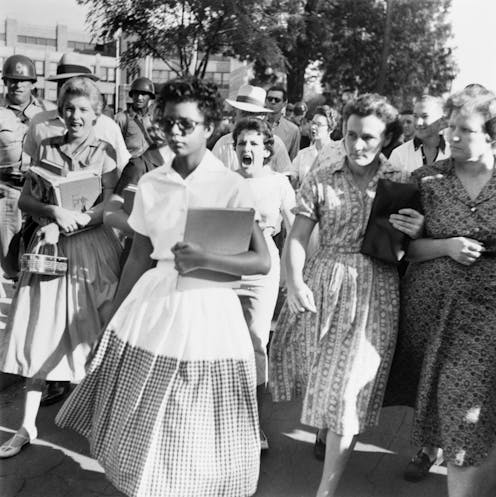How did white students respond to school integration after Brown v. Board of Education?
- Written by Charise Cheney, Associate Professor of Ethnic Studies, University of Oregon

Jones, whose parents had urged kindness, was upset when she found out about violence that erupted in other places across the nation.
“We never saw anything like that in Topeka[9],” she recalled in 2019.
Americans’ collective historical memory of desegregation is filled with visual images of white resistance in Southern cities like Little Rock, Arkansas, in 1957 and northern cities like Boston in 1974.
One iconic photo was taken at Little Rock’s Central High School on Sept. 4, 1957. That day, Arkansas Gov. Orval Faubus ordered the Arkansas National Guard to block Black students’ entry into the school[10]. Local newspaper photographer Will Counts photographed one of the Black students, 15-year-old Elizabeth Eckford, after she was turned away from school. Eckford was surrounded by white students in the picture, as one named Hazel Bryan, also 15, is yelling at her.
The picture quickly spread through national news outlets, and Bryan became the symbolic face of Southern white racism. The notoriety haunted Bryan, who apologized to Eckford five or six years later[11].
While Bryan and her fellow students became a public spectacle, the fact that most whites did nothing was less remarked upon.
White students who supported integration knew that if they came to Black students’ aid, they risked social repercussions, or worse. Central High junior Robin Woods was “ashamed” of her peers’ behavior outside of school that September day, but did not get involved. When a Black classmate forgot his math book that day, though, Woods shared hers. That act of kindness was met with a “gasp of disbelief[12],” and a year of harassment followed.
Central High School senior Marcia Webb also witnessed her peers’ aggression toward the integrating Black students, who became known as the “Little Rock Nine[13].” At the time she was more interested in high school dances and athletic events than the emerging political storm, a racial privilege that was denied her new Black classmates.
“I’m sorry to say now, looking back, that what was happening didn’t have more significance and I didn’t take more of an active role,” she recalled. “But I was interested in the things that most kids are.”
As an adult, Webb expressed regret for her unwillingness to intervene:
“[H]urt can come from words, from silence even, from just being ignored[14].”
Hello, curious kids! Do you have a question you’d like an expert to answer? Ask an adult to send your question to CuriousKidsUS@theconversation.com[15]. Please tell us your name, age and the city where you live.
And since curiosity has no age limit – adults, let us know what you’re wondering, too. We won’t be able to answer every question, but we will do our best.
References
- ^ Curious Kids (theconversation.com)
- ^ curiouskidsus@theconversation.com (theconversation.com)
- ^ Brown v. Board of Education (www.archives.gov)
- ^ opposing public school segregation (www.nps.gov)
- ^ history of Kansas (www.history.com)
- ^ be friendly with the new students and to treat them with kindness and respect (www.cjonline.com)
- ^ It turned out to be one of the best things of my life (www.cjonline.com)
- ^ AP Photo/PBR (newsroom.ap.org)
- ^ We never saw anything like that in Topeka (www.cjonline.com)
- ^ block Black students’ entry into the school (www.americaslibrary.gov)
- ^ apologized to Eckford five or six years later (www.npr.org)
- ^ gasp of disbelief (www.facinghistory.org)
- ^ Little Rock Nine (www.history.com)
- ^ [H]urt can come from words, from silence even, from just being ignored (www.facinghistory.org)
- ^ CuriousKidsUS@theconversation.com (theconversation.com)

















